Last updated: May 27, 2025
Article
Motorcycle Safety

NPS Image
A Different Ride
Did you know that riding your motorcycle on park roads can be very different than riding on other routes? The road design, wildlife activity, and diverse landscape of parks can make riding more challenging than other roadways. In addition, park scenery can be distracting and cause you to take your eyes off the road.
Read ahead to learn about unique features of park roads, how they can impact your ride, and what you can do to reduce the risk of injury and damage to your motorcycle so you can ride for the long haul.
KEY SAFETY MESSAGES
- Slow down on curves - Be prepared for continuous curves and tight curves after long straightaways.
- Ride in the Center of the Lane (on Narrow Lanes & Roads with Limited Shoulders) - This position gives you more space to maneuver without drifting into oncoming traffic or off the road.
- Scan the road and shoulders for wildlife - Wildlife can often be found feeding on the side of the road and unexpectedly crossing it, especially at dusk and dawn.
- Increase following distance - Give vehicles and riders around you space to safely navigate the road.
- Pull over to a designated area – This is the best place to rest and safely take in the stunning view.
Learn more about:
Park Roads Have:
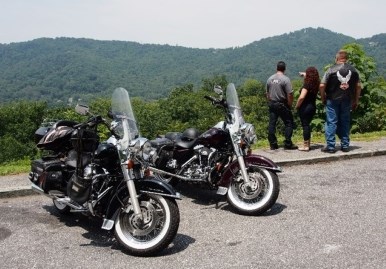
NPS Photo
Views
Park roads often lead to some of the best areas to enjoy your surroundings. It’s easy to get caught up in the beauty around you and take your eyes off the road
RIDING TIP: Pull over to a designated area so you can safely take in the view.

NPS Photo by Robert Burton
Wildlife
Crashes involving animals in parks are double the national rate. Park roads often cross wildlife habitats or migration routes increasing the likelihood of an encounter.
RIDING TIP: Scan the road and shoulders for wildlife and be prepared to stop.
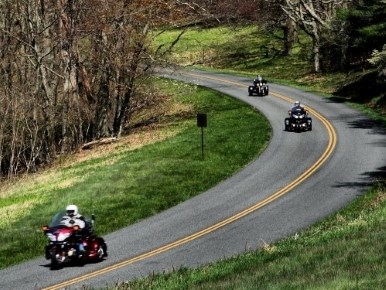
NPS Photo by Alex Armstrong
Narrow lanes, limited shoulders, and fewer pull offs.
Park roads have narrow lanes with limited to no shoulders, especially in areas with drop offs, retaining walls, or protected resources. This leaves no room for error. If you leave the road, you may not have the ability to correct your lane position or pull over safely.
RIDING TIP: Follow the speed limit, ride in center of lane, and ride in single file if traveling with a group.
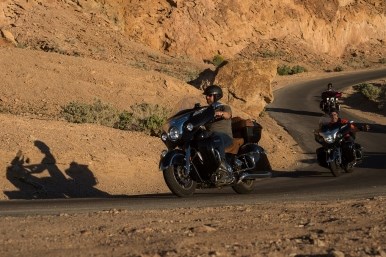
NPS Photo by Kurt Moses
Limited to no road markings
There may be stretches of road that don’t have pavement markings for the centerline or shoulders. The paved road edges can blend into the landscape, especially during bad weathe, like fog or rain, or at night. If a driver leaves the road in these areas and the shoulder is soft, you may not be able to correct your position.
RIDING TIP: Stay alert of your lane position and follow the speed limit.
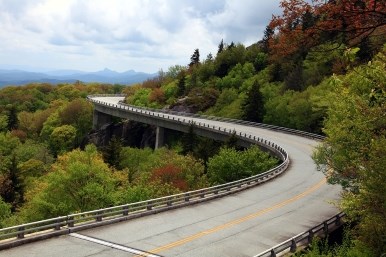
NPS Photo
Decreasing Radius Curves
Curves become tighter as you travel through it, especially going downhill. This is often done to reduce the impact on the natural or cultural resources.
RIDING TIP: Slow down on curves, stay alert to your lane position, increase following distance.
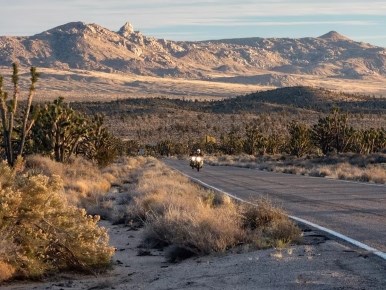
NPS Photo by K. Lewandowski
Few Places to Stop
Shelters and rest stops are few and far between in some parks. Park maps provide information on locations where you can find shelter when weather or fatigue hits.
RIDING TIP: Plan ahead for where you can stop if conditions change and it’s not safe to ride.
Helmet Laws
Wearing a helmet while riding in national parks is highly recommended. Be aware that parks adopt and enforce state law for mandatory helmet wear while riding. A list of motorcycle laws can be found at the Governor’s Highway Safety Association. Check the laws before your visit to ensure you bring your helmet if required.
Special Considerations for Riding in a Group
Keep these important safety tips in mind when riding in the park with your group:
- Ride single file on narrow lanes– some park roads are narrower than other public roads. Riding next to each other may not allow enough room for proper lane positioning.
- Give plenty of space – allow the rider in front of you room to navigate turns and to slow down if they encounter wildlife or traffic jams.
- Focus on YOUR ride – stay alert and in charge of your own motorcycle. Don’t be distracted by the other riders around you.
- Group requirements – check the “Learn about the Park” page to find out if there are group size restrictions or permitting requirements for organized group rides before you head out. These types of restrictions can apply to motorcycle riders. Regulations, restrictions, and closures protect park resources and keep visitors safe.
Why Ride in the Center of the Lane?
Lane position is critical for riders to be seen by other motorists. It is also crucial for motorcyclist to react to other motorists and environmental conditions such as wildlife and road hazards. Choosing the best lane position for conditions provides visibility, escape routes, and more reaction time.
Motorcycle safety programs generally recommend riding in the leftmost or rightmost third of the lane, as these positions can offer better visibility and space cushions in many situations. However, for national park roads with narrow lanes or roads with limited to no shoulders, consider riding in the center of the lane. This riding position gives you the most space to maneuver safely without drifting into oncoming traffic or off the road.
Ultimately, lane positioning is dynamic and changes with road conditions, traffic patterns, and the presence of hazards. We encourage every rider to use good judgment and choose the lane position best suited to the road’s design and surrounding conditions.
Press Kit
Interested in helping raise awareness about motorcycle safety in national parks? Use this Motorcycle Safety Press kit which includes everything you need from campaign background to safety tips and key resources. We invite you to join us in helping riders prepare for an injury-free visit so they can ride for the long haul!
